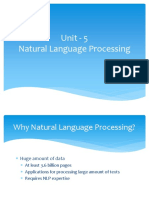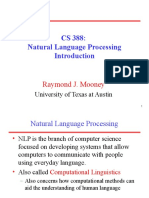NLP Final
NLP Final
Uploaded by
hohepo9944Copyright:
Available Formats
NLP Final
NLP Final
Uploaded by
hohepo9944Copyright
Available Formats
Share this document
Did you find this document useful?
Is this content inappropriate?
Copyright:
Available Formats
NLP Final
NLP Final
Uploaded by
hohepo9944Copyright:
Available Formats
Q1) a) What do you mean by part-of-speech Tagging? What is the need of this task in NLP.
Part-of-speech tagging is the process of assigning grammatical categories (such as noun, verb, adjective) to
words in a text.
Need for Part-of-Speech Tagging in NLP
1) Syntactic Analysis: Helps identify the role of words in a sentence for parsing and grammar
analysis.
2) Semantic Analysis: Aids in understanding the meaning of words and their relationships in a
sentence.
3) Machine Translation: Facilitates accurate translation by preserving grammatical structure.
4) Information Retrieval: Enhances search accuracy by considering word usage and context.
5) Named Entity Recognition (NER): Identifies and categorizes named entities like people,
organizations, and locations.
6) Text-to-Speech Systems: Assists in generating natural-sounding speech by providing proper
pronunciation cues.
7) Grammar Checking: Enables automated proofreading and correction by identifying word
usage errors.
8) Information Extraction: Supports extracting relevant information from text by understanding
word roles.
9) Improving NLP Models: Contributes to training better NLP models by providing labeled data
for supervised learning.
b) Differentiate between natural languages and programming languages.
NO Natural language processing Programming Language
1 Connected in processing the human natural Way of writing instructions to the computer
language
2 Generates human language syntax Strict syntax for every language
3 enable computers to interact with human Solve the task and computational problems
language
4 Works with unstructured and speech data Works with structured data, variables, and
program logic
5 Focuses on processing and understanding Used for specifying algorithms and manipulation
human language text data
6 Chatbots, language translation, speech develop software, applications and algorithms
recognition, etc
7 Ex. machine translation, sentiment analysis Ex. C, C++,java, python etc.
8 Tools. NLTK, TensorFlow Tools. IDEs (Integrated Development
Environments), compilers
c) Explain Tokenization with its different types.
- process of breaking down a text into smaller units called tokens.
- tokens are usually words, phrases, or symbols.
Types of Tokenization:
1) Word Tokenization: breaking a text into individual words
Ex. "The quick brown fox jumps over the lazy dog" is tokenized into ["The", "quick", "brown", "fox",
"jumps", "over", "the", "lazy", "dog"].
2) Sentence Tokenization: splitting a text into individual sentences.
Ex. "This is the first sentence. This is the second sentence." is tokenized into ["This is the first
sentence.", "This is the second sentence."].
3) Whitespace Tokenization: using spaces as separators to break the text into tokens.
Ex. "The sun is shining" is tokenized into ["The", "sun", "is", "shining"].
4) Punctuation Tokenization: using punctuation marks as separators to split the text into
tokens.
Ex. "He said, 'Hello! How are you?'" is tokenized into ["He", "said", ",", "'Hello", "!", "How", "are", "you",
"?", "'"].
5) Morphological Tokenization: breaking down words into their root forms
Ex. For "running," the morphological tokenization might include ["run", "-ing"].
Q2) a) What is Natural Language Processing (NLP)? Discuss various stages involved in NLP process with suitable
example.
- (NLP) is a subfield of AI
- It focuses on the interaction between computers and human language.
- It enable machines to understand, interpret, and generate human language.
Stages:
1) Text Acquisition: Gathering relevant textual data.
Ex. Extracting text from news articles for sentiment analysis or information retrieval.
2) Preprocessing: Cleaning and preparing the data for analysis.
Ex. Converting all text to lowercase and removing common words like "the" and "and" to
reduce noise in the data
3) Tokenization: Breaking text into individual words or tokens.
Ex. Tokenizing the sentence "The cat is sleeping" into ["The", "cat", "is", "sleeping"].
4) Part of Speech Tagging: Assigning grammatical categories to tokens.
Ex. Tagging "The cat is sleeping" as [Determiner, Noun, Verb, Verb] where "The" is a
determiner, "cat" is a noun, and so on.
5) Parsing: Analyzing the syntactic structure of sentences.
Ex. Parsing the sentence "The cat chased the mouse" to understand the subject-verb-object
relationship.
6) Semantic Analysis: Understanding the meaning of the text.
Ex. Determining the semantic similarity between two sentences, such as "The cat is on the
mat" and "A feline is resting on the rug."
7) Discourse Integration: Coherent interpretation of a sequence of sentences.
Ex. Understanding the narrative flow and connection between sentences in a paragraph or
document.
b) Discuss the challenges of Natural Language Processing.
1) Ambiguity: Words and phrases often have multiple meanings.
Ex. In the sentence "I saw her duck," the word "duck" could be a bird or an action (to lower oneself).
2) Context Dependency: Interpretation depends on context.
Ex. The word "bank" can refer to a financial institution or the side of a river, depending on context.
3) Lack of Standardization: Languages evolve, introducing variations.
Ex. Differences in spelling between British and American English (e.g., "colour" vs. "color") can pose
challenges.
4) Cultural Nuances: Understanding cultural context in language.
Ex. Idiomatic expressions and culturally specific references may be challenging for models trained on a
different cultural context
5) Handling Rare Cases: Dealing with uncommon or specialized terms.
Ex. Technical jargon in niche fields may be challenging for models without specific domain knowledge
6) Data Privacy and Security: Data privacy and security require careful management in
language processing tasks.
Ex. Disambiguating between the different senses of "bat" (e.g., a flying mammal or a sports
equipment) in a given context
Q3) a) Derive a top-down, depth-first, left-to-right parse tree for the given sentence: “The angry bear chased
the frightened little squirrel” Use the following grammar rules to create the parse tree:
S -> NP VP Det -> the
NP -> Det Nom Adj -> little | angry | frightened
VP -> V NP N -> squirrel | bear
Nom -> Adj Nom | N V -> chased
b) Explain Derivational and Inflectional morphology in detail with suitable example.
Derivational Morphology: Process of creating new words by adding prefixes, suffixes, or morphemes
to change meaning or grammatical category.
Ex. 1) Create → Creation (Verb to Noun)
2) Friend → Friendly (Noun to Adjective)
3) Nation → National (Noun to Adjective)
4) Deep → Deepen (Adjective to Verb)
Inflectional Morphology: Adding morphemes to convey grammatical information without altering
meaning.
Ex. 1) Walk → Walks (3rd person singular)
2) Child → Children (Plural)
3) Run → Ran (Past Tense)
4) Sing → Singing (Present Participle)
Q4) a) What is Probabilistic context-free grammars? State the benefits of probabilistic parsing
Probabilistic Context-Free Grammars (PCFG):
Extends context-free grammars with probabilities for production rules, commonly used in syntactic
parsing.
Benefits of Probabilistic Parsing:
1) Capturing Ambiguity
2) Statistical Learning
3) Flexible Language Modeling
4) Handling Out-of-Vocabulary Words
5) Syntactic Disambiguation
6) Adaptability to Different Domains
7) Scalability
b) Explain with suitable examples following relationship between word meanings, 1. Homonymy 2. Polysemy 3.
Synonymy 4. Hyponymy
1) Homonymy: Words with different meanings but the same form.
Ex. "bat" (flying mammal) vs. "bat" (sports equipment)
2) Polysemy: Words with multiple related meanings
Ex. "bank" (financial institution) vs. "bank" (river's edge)
3) Synonymy: Words with similar meanings.
Ex. "big" and "large"
4) Hyponymy: Relationship between a general term and specific instances.
Ex. "rose" is a hyponym of "flower"
You might also like
- Cambridge IGCSE English As A Second Language Workbook (Fourth Edition) - PublicDocument22 pagesCambridge IGCSE English As A Second Language Workbook (Fourth Edition) - Publicmyatmoon100% (2)
- (A) What Is Traditional Model of NLP?: Unit - 1Document18 pages(A) What Is Traditional Model of NLP?: Unit - 1Sonu KumarNo ratings yet
- How To Register For UNIT 1 Linguistics: 2 What Happens When A Language Disappears?Document2 pagesHow To Register For UNIT 1 Linguistics: 2 What Happens When A Language Disappears?Lay Lyly100% (1)
- SNLPDocument18 pagesSNLPprogramerpj69No ratings yet
- AI-MODULE 4Document28 pagesAI-MODULE 4mahimanoj1102003No ratings yet
- Chapter 6-NLP BasicsDocument27 pagesChapter 6-NLP Basicsamanterefe99No ratings yet
- NLP Unit 1Document18 pagesNLP Unit 1okspam12345No ratings yet
- Unit - 4 DLDocument33 pagesUnit - 4 DLgauravgautam268No ratings yet
- DLT Unit-5Document48 pagesDLT Unit-5TONY 562No ratings yet
- NLP Mod 1 SEEDocument7 pagesNLP Mod 1 SEEkhushichourasia0303No ratings yet
- computers and linguisticDocument6 pagescomputers and linguisticIsti Rahma ChintaNo ratings yet
- Natural Language ProcessingDocument25 pagesNatural Language Processingpriyanshudhaked00No ratings yet
- Group Assignment: Unit OneDocument27 pagesGroup Assignment: Unit OneKena hkNo ratings yet
- Lecture 2 NLPDocument27 pagesLecture 2 NLPYoussef MohamedNo ratings yet
- 3nlp ComputerDocument83 pages3nlp ComputerMustafaBaseimNo ratings yet
- Brocode OPDocument133 pagesBrocode OPaditijain3727No ratings yet
- Unit VDocument38 pagesUnit VYuv RajNo ratings yet
- NLP Lab Manual-1Document18 pagesNLP Lab Manual-1kalanadhamganapathipavankumarNo ratings yet
- Chapter OneDocument27 pagesChapter Oneahmed neccarNo ratings yet
- Unit 1 NLP and TADocument9 pagesUnit 1 NLP and TAsunnyavisingh13No ratings yet
- NLP Lect Unit IDocument140 pagesNLP Lect Unit Ishravan3394No ratings yet
- NLP Question bankDocument27 pagesNLP Question bankshuklachinmay2168No ratings yet
- 9783293-CLASS10 AI Worksheet PART B UNIT6 Natural Language Processing (1)Document3 pages9783293-CLASS10 AI Worksheet PART B UNIT6 Natural Language Processing (1)whyyoubulime0No ratings yet
- Unit - 5 Natural Language ProcessingDocument66 pagesUnit - 5 Natural Language ProcessingMeghaNo ratings yet
- Solutions To NLP I Mid Set ADocument8 pagesSolutions To NLP I Mid Set Ajyothibellaryv100% (1)
- SLP Unit-IDocument39 pagesSLP Unit-Ideepthinagella09No ratings yet
- lect1-intro-3jan08 (1)Document94 pageslect1-intro-3jan08 (1)dayanandNo ratings yet
- Chapter 1Document5 pagesChapter 1bhelravisoniNo ratings yet
- AzmerawFinalDocument11 pagesAzmerawFinalkassyemariyam21No ratings yet
- NLP Insem NotesDocument13 pagesNLP Insem Notestaslimarif makandarNo ratings yet
- NLP 1Document29 pagesNLP 1temporary.mail.coNo ratings yet
- Natural Language ProcessingDocument8 pagesNatural Language ProcessingTALISHANo ratings yet
- AI ASSIGMENT 1 (1) (1)Document4 pagesAI ASSIGMENT 1 (1) (1)kaleemiqra32No ratings yet
- Lecture1Document16 pagesLecture1P.V.Hemavathi VISTASNo ratings yet
- nlp 9 queDocument10 pagesnlp 9 quekaranjoshi2104No ratings yet
- Session 11-12 - Text AnalyticsDocument38 pagesSession 11-12 - Text AnalyticsShishir GuptaNo ratings yet
- IntroDocument56 pagesIntronyoman sNo ratings yet
- NLP Unitwise Imp QuestionsDocument5 pagesNLP Unitwise Imp Questionsmy storiesNo ratings yet
- Ai Unit - 5Document12 pagesAi Unit - 5KaranNo ratings yet
- FALLSEM2019-20 CSE4022 ETH VL2019201002590 Reference Material I 17-Jul-2019 NLP1-Lecture 4Document34 pagesFALLSEM2019-20 CSE4022 ETH VL2019201002590 Reference Material I 17-Jul-2019 NLP1-Lecture 4Anonymous TpYSenLO8aNo ratings yet
- NLP Notes (Ch1-5) PDFDocument41 pagesNLP Notes (Ch1-5) PDFVARNESH GAWDE100% (1)
- SlidesDocument26 pagesSlidescoderyami18No ratings yet
- Natural Language ProcessingDocument49 pagesNatural Language ProcessingBharti Gupta100% (5)
- KE -CIA 1 IMPORTANT QUESTIONS with ANSWERSDocument12 pagesKE -CIA 1 IMPORTANT QUESTIONS with ANSWERSSANJAY AATHARSHNo ratings yet
- NLP-Unit-1-part1Document61 pagesNLP-Unit-1-part1avvaruannapurna693No ratings yet
- NLP FINALDocument33 pagesNLP FINALAdithya Varma GNo ratings yet
- NLP NotesDocument16 pagesNLP Noteschandini9369No ratings yet
- Natural Language ProcessingDocument5 pagesNatural Language ProcessingVidhu VohraNo ratings yet
- Unit-III-1Document11 pagesUnit-III-1paij6328No ratings yet
- SampleDocument8 pagesSampleSasi DharNo ratings yet
- Lecture 2Document151 pagesLecture 2Abdullah Khan QadriNo ratings yet
- NLP Exam All AnswersDocument4 pagesNLP Exam All Answersnustakaam00No ratings yet
- NLP Short Que AnsDocument21 pagesNLP Short Que AnsSouvik MondalNo ratings yet
- An Introduction To SyntaxDocument2 pagesAn Introduction To SyntaxkrzysiekwieNo ratings yet
- NLP Study Materials UpdatedDocument43 pagesNLP Study Materials UpdatedCHARU SINGHNo ratings yet
- Important 2 MarksDocument11 pagesImportant 2 Marksjmjannie7_90581560No ratings yet
- Previous_year_Question_paper_NLP (2)Document5 pagesPrevious_year_Question_paper_NLP (2)alwynbgsNo ratings yet
- Assignment of AI FinishedDocument16 pagesAssignment of AI FinishedAga ChimdesaNo ratings yet
- NLP NotesDocument18 pagesNLP NotesalluarjunrrrrNo ratings yet
- What Is NLPDocument3 pagesWhat Is NLPchessyrohanNo ratings yet
- 2.monthly Distribution of NovemberDocument4 pages2.monthly Distribution of NovemberHiba SahiNo ratings yet
- Past ContinuousDocument2 pagesPast ContinuousSabina Lucia GrapiniNo ratings yet
- On The Road VocabularyDocument1 pageOn The Road VocabularyIep Inicial Jesus EnmanuelNo ratings yet
- Telling Past Experiences: Bahasa Inggris WajibDocument15 pagesTelling Past Experiences: Bahasa Inggris WajibfadhilNo ratings yet
- Is The Customer King?: Warm-UpDocument5 pagesIs The Customer King?: Warm-UpYaritza PérezNo ratings yet
- Reading Intervention Action Plan For Frustration and Non-Readers SY 2020-2021Document2 pagesReading Intervention Action Plan For Frustration and Non-Readers SY 2020-2021December Cool100% (2)
- Sample TB3 1Document40 pagesSample TB3 1Amiko SikharulidzeNo ratings yet
- TAGALOG LessonGuide3 TransitioningDocument24 pagesTAGALOG LessonGuide3 TransitioningChar ReyelNo ratings yet
- TensesDocument6 pagesTenses2cbnk4gwtwNo ratings yet
- IELTS General Task Notes 1Document7 pagesIELTS General Task Notes 1zishNo ratings yet
- English10 q4 w6 Mod6Document16 pagesEnglish10 q4 w6 Mod6Valestin Y.100% (1)
- IE KloekhorstPronk-2019 (Precursors)Document243 pagesIE KloekhorstPronk-2019 (Precursors)German Dziebel100% (1)
- Video Debate PresentationDocument8 pagesVideo Debate Presentationapi-629724424No ratings yet
- MTB 1 LRDocument18 pagesMTB 1 LRMark James SaliringNo ratings yet
- Insight Pre Intermediate SB WWW Frenglish Ru-1-1-16Document16 pagesInsight Pre Intermediate SB WWW Frenglish Ru-1-1-16Luca Querzoli0% (1)
- POV Meddling Mother-In-LawDocument2 pagesPOV Meddling Mother-In-LawPhanQuangHuyNo ratings yet
- Future Continuous Passive VoiceDocument3 pagesFuture Continuous Passive VoiceReinaldo FigueroaNo ratings yet
- INT-T1 - IELTS Writing Task 1 AssessmentDocument8 pagesINT-T1 - IELTS Writing Task 1 AssessmentNguyen KiraNo ratings yet
- 02 Complete IELTS 5-6.5 Unit 1Document9 pages02 Complete IELTS 5-6.5 Unit 1R. RabNo ratings yet
- Skill Lessons - Prefixes and Suffixes PDFDocument12 pagesSkill Lessons - Prefixes and Suffixes PDFHal FianNo ratings yet
- Week 3 Summarizing LectureDocument28 pagesWeek 3 Summarizing LectureHernan DigoNo ratings yet
- Daily Lesson PlanDocument8 pagesDaily Lesson PlanamsyarNo ratings yet
- Grade 6 Writing An EditorialDocument18 pagesGrade 6 Writing An EditorialMorris CarrealNo ratings yet
- SEMANTIC Vs PRAGMATICSDocument13 pagesSEMANTIC Vs PRAGMATICSA. TENRY LAWANGEN ASPAT COLLENo ratings yet
- Course Outline MandarinDocument4 pagesCourse Outline MandarinClotyMamhunzeNo ratings yet
- Prefixes SuffixesDocument2 pagesPrefixes SuffixesMalee Polyglot100% (2)
- QUANTIFIERS MindmapDocument2 pagesQUANTIFIERS MindmapHuyền BùiNo ratings yet
- French and Tây B I in VietnamDocument239 pagesFrench and Tây B I in VietnamWilliam German ButcherNo ratings yet

























































































